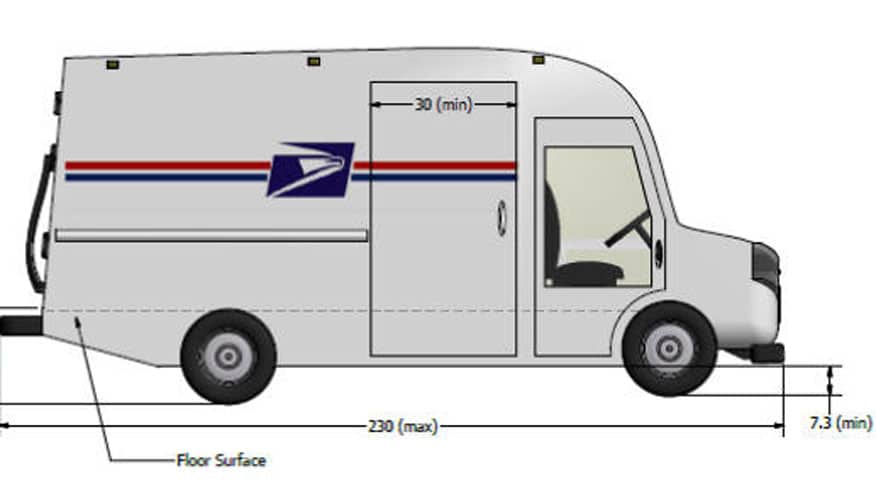 By Sarah Ninvaggi – January 15, 2015
By Sarah Ninvaggi – January 15, 2015
The following information outlines the Postal Service’s position on our Next Generation Delivery Vehicle acquisition process.
In order to understand the investment in Next Generation Delivery Vehicles, it is important to understand some background on the Postal Service’s fleet. While many would recognize our familiar right-hand-drive Long Life Vehicles used in communities across the country, we actually operate a varied fleet including multiple size options and alternative fuel vehicles. We are currently in the process of purchasing and deploying some commercially available cargo vans and mixed delivery trucks that are used to support certain elements of delivery operations, in addition to right-hand drive delivery vehicles.
However, just as the Long Life Vehicles have served the nation for more than 20 years in delivery, our Next Generation Delivery Vehicles will also have a unique mission. The Postal Service has a universal service mandate to deliver the mail almost every day to every address – and that mandate is at the core of our investment decision. Considerations that are distinct to our business, such as the stop-and -go nature of delivering mail and packages, and the ability to conveniently reach mailboxes, must be taken into account when acquiring this fleet. These considerations require some level of customization, as most commercial vehicles do not generally meet these specified delivery needs.
The goal of this acquisition program is to develop a future class of delivery vehicles that will incorporate new technologies to better accommodate a diverse mail mix, enhance safety, improve service, reduce emissions and produce operational savings. The Postal Service will take advantage of commercially available technologies and design elements the industry has to offer as we purchase Next Generation Delivery Vehicles. It is also important to note that we are seeking durable vehicles with a long life span over a multi-year deployment period in part so we can foster an innovative platform with the ability to adapt as new technologies and opportunities become available.
The Postal Service received extensive input from stakeholders following the release of an initial Request for Information for next generation vehicles. As a result of this feedback, we reevaluated key elements of our requirements, and released a Request for Proposal with a broader statement of objectives. This decision was intended to increase flexibility during this phase of the acquisition process to ensure we are capturing the range of options available in the industry.
The procurement of Next Generation Delivery Vehicles is a multi-year, phased process of which we are in the fairly early phases. Supplier capability to produce a significant quantity of delivery vehicles was a requirement in order to be considered for prequalification; however, we have not made any commitments to purchasing just one type of vehicle. The Postal Service is interested in exploring the potential for a mixed delivery vehicle fleet, which could include multiple vehicle models to meet different delivery needs across the country, potentially utilizing more than one type of fuel source.
The Postal Service has consulted with many stakeholders including members of Congress, federal agencies, the automotive industry, postal unions and employees to develop a best-in-class request for proposal for Next Generation Delivery Vehicle prototypes. Our intention is that the cross-functional and open nature of our process will allow us to take advantage of the latest in private sector best practices and vehicle innovation to meet our evolving and varied delivery needs.
Additional Background information:
The USPS operates a fleet of more than 200,000 vehicles in all areas of the United States and its territories. Approximately 163,000 of these vehicles are Long-Life vehicles (LLVs) purchased between 1987 and 2001. In addition to LLVs, we utilize vans, 2-ton vehicles, alternative fuel vehicles and tractor trailers. The Postal Service also delivers through a diverse fleet across the U.S. that includes bikes, boats, planes, helicopters, and even mules.
At an average age of 25 years old, most of our LLV delivery fleet is near or beyond its designed useful life. The Postal Service intends to replace many of these vehicles with Next Generation Delivery Vehicles (NGDVs).
The Postal Service released a Request for Information in January 2015, which began the procurement process. The Postal Service released a Request for Proposals for NGDV prototypes in October 2015. We expect to award contracts for prototypes in the spring of 2016, with delivery scheduled within one year. We plan to test the vehicles from the spring through fall of 2017. The lessons learned from the prototype testing process will be incorporated in the future production RFP, which is anticipated to be released in early 2018, with a final contract awarded later in 2018. We plan to begin deployment of the production vehicles by the summer of 2019.
There are 15 prequalified suppliers who are eligible to respond to the RFP for prototype development.
Source: USPS Blog

Union and NAME of Local/Branch
NRLCA - Jackson MI